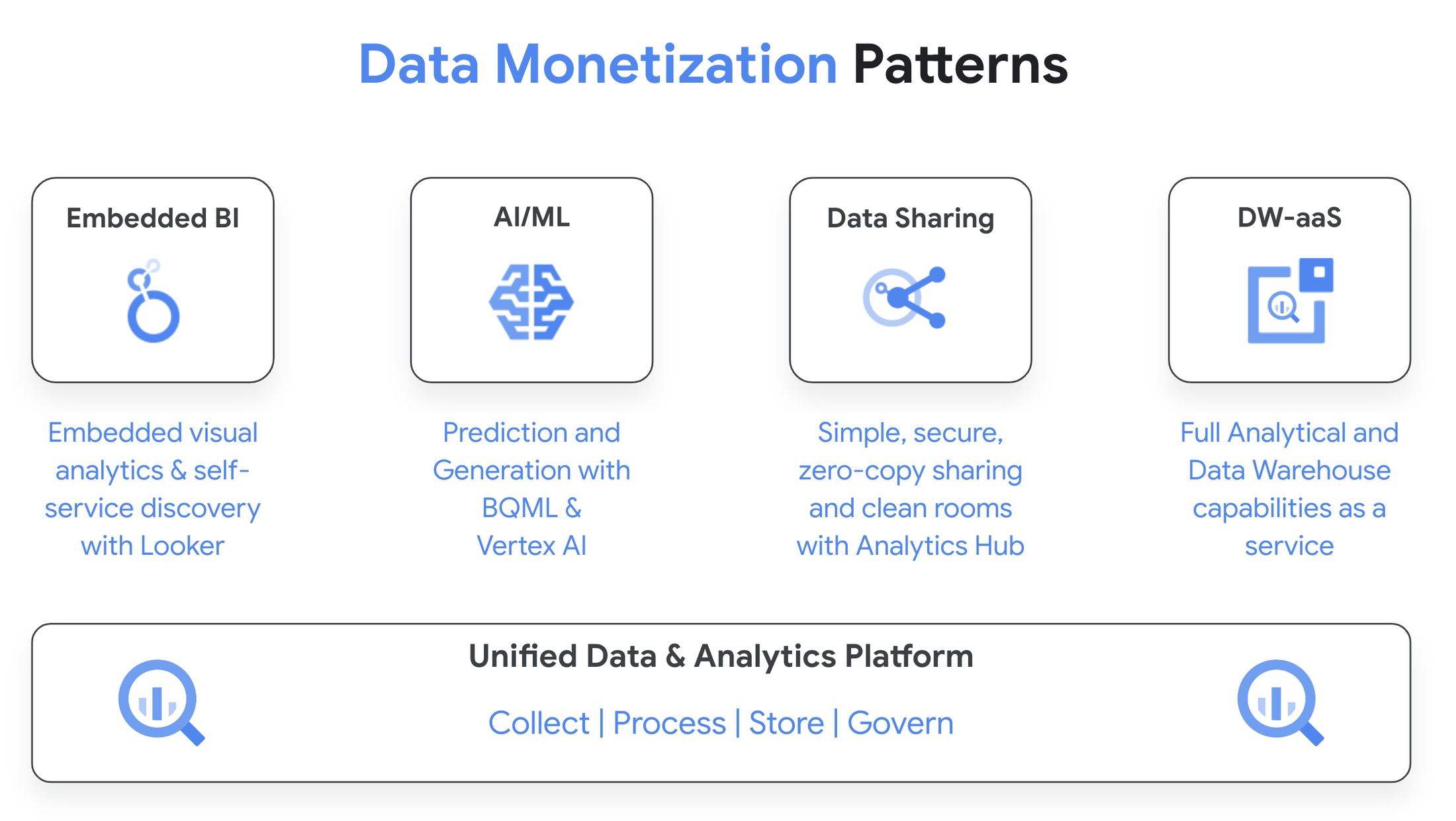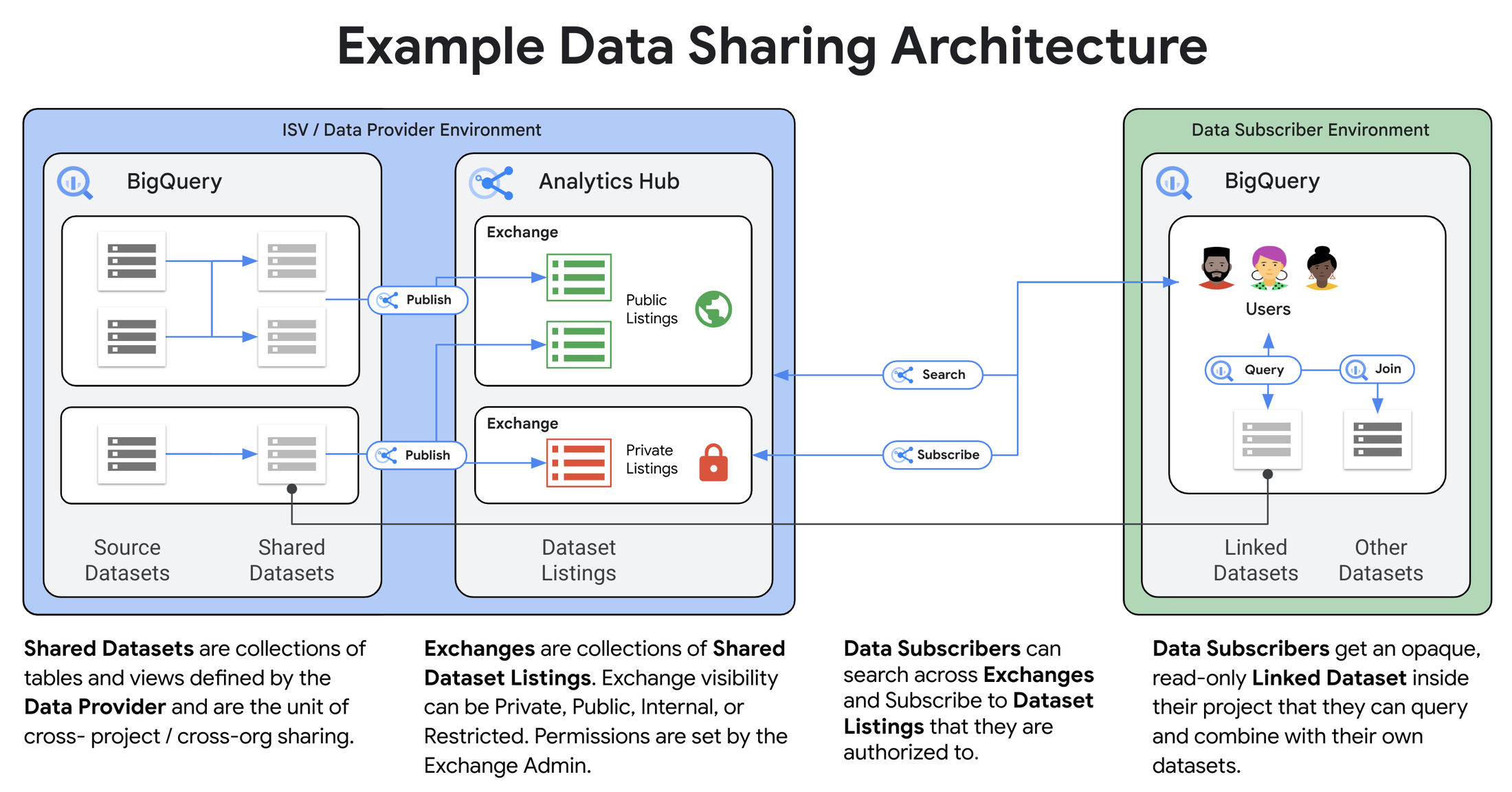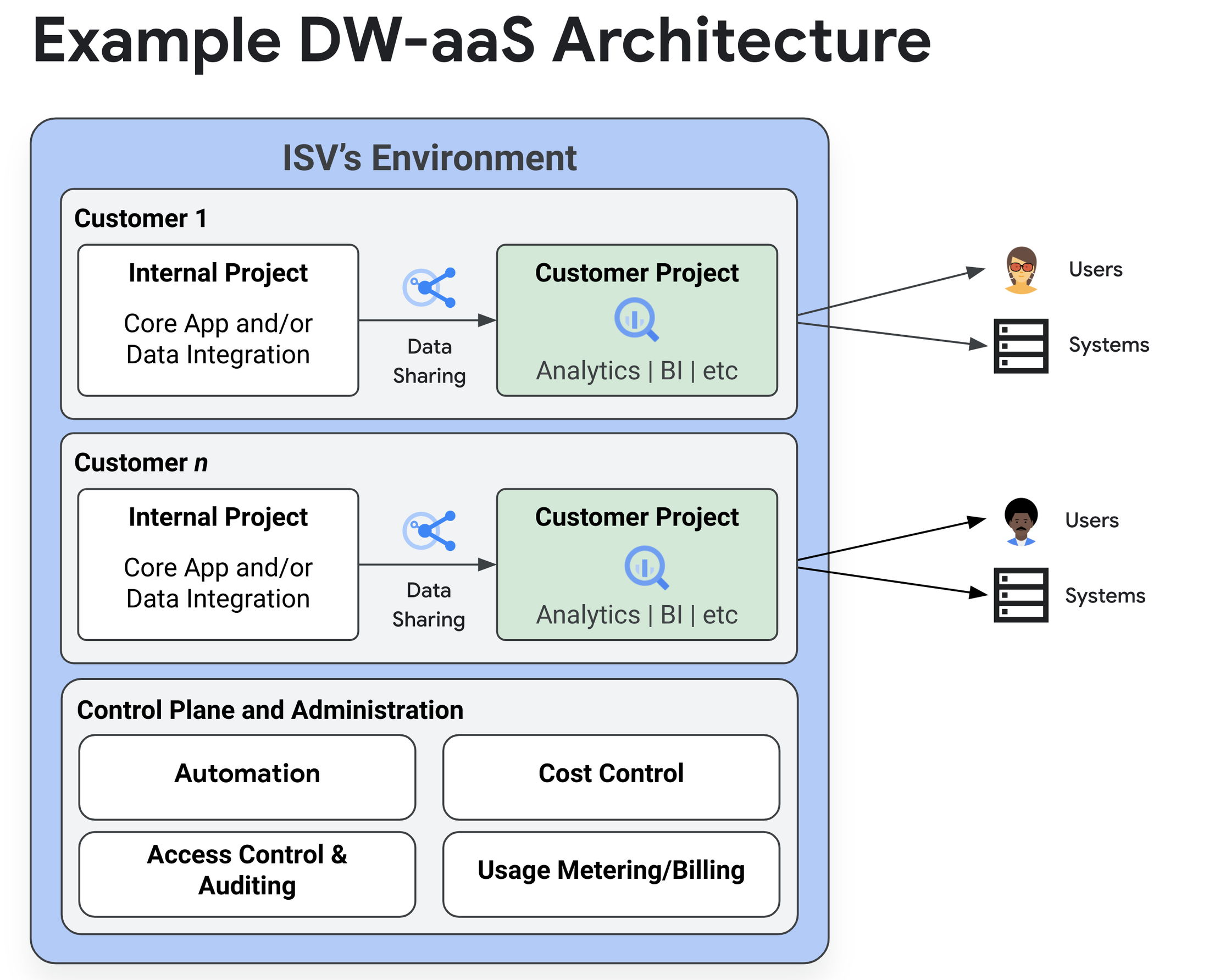Built with BigQuery: Drive growth through data monetization
Since the launch of Built with BigQuery was first announced at the Data Cloud Summit in April 2022, Google gained some incredible momentum. Now, over 1000 ISVs and data providers are using BigQuery and Google Data and AI Cloud to power their applications.
At Google Cloud Next this year, Google were lucky enough to be joined by some of these partners in person, where Google talked about driving growth through data monetization.
The four companies we spoke with, Exabeam, Dun & Bradstreet, Optimizely and LiveRamp are all leaders in their fields, so we wanted to share some of the key ways they are using BigQuery and Google Data and AI Cloud to drive growth through data monetization.
Data monetization
Organizations across industries have seen an explosion in the data they generate over the last decade and it’s often said to be a company’s most valuable resource. However, the reality is that the raw data generated is often little more than a byproduct of other processes, and can be costly to store, protect and govern. To have value, and to be monetizable, raw data must be transformed into a data product. So what do we mean by a data product? At a minimum, data products must:
- Have a development lifecycle, roadmap and distribution
- Provide value to customers by satisfying a need or want
- Provide value to data providers through direct (i.e. net new revenue via upsell & cross sell) and/or indirect (e.g. Increased differentiation, usage & stickiness) monetization
When working with ISVs and data providers across the ecosystem, we see four key recurring patterns that use the BigQuery suite to power data products.

- Embedded BI: Embedded visual analytics & self-service discovery with Looker. For an excellent deep-dive into this topic, see the Google Cloud Next ‘23 session Data monetization through embedded analytics.
- Gen AI/ML: Predictive and Generative AI with BigQuery ML & Vertex AI. To hear more about the latest innovations in this space, check out the webinar: How ISVs can accelerate Gen AI adoption with BigQuery
- Data sharing: Simple, secure, zero-copy sharing and clean rooms with Analytics Hub. Learn more about the latest innovations in data sharing and data clean rooms, at the Google CLoud Next ‘23 session: Share securely with data clean rooms
- Data warehouse as a service: Partners can enable their customers with the full Analytical and Data Warehouse capabilities of BigQuery, by providing them as a service. A great example of this is Bloomreach Engagement BQ.
Foundational to all of these is the need to unify datasets into a common data and analytics platform.
In the stories that follow, you’ll see examples of how companies are leveraging these patterns to monetize their data assets and deliver value for their customers.
Exabeam delivers consistent and repeatable security investigations
Exabeam, Google Cloud Tech Partner of the year for Security Analytics and a global cybersecurity leader delivering AI-driven security operations, provides security operations teams with end-to-end Threat Detection, Investigation, and Response (TDIR).
Andy Skrei, VP of Product Management, explained that when Exabeam adopted BigQuery two years ago, their key goal was to deliver a platform-level data store that could collect and normalize all data once, and then use it in different ways through different applications and data products from search through detection and response. One of the primary drivers was security analytics, and the company needed a data store that could scale to drive the detection capabilities that its customers expect.
Exabeam also wanted to give customers access to the data store to query it during security investigations. For this, they needed customers to have the ability to ingest all of the data they care about; to be able to retain that data for up to 10 years based on compliance and investigation needs; and be able to access that data at scale quickly. They also needed to make sure that customers had the ability to craft complex queries, access the right insights, and aggregate that data.
The key to all of these need is making sure that the solution can scale based on demand. When you’re in an incident or a breach, you may have 10x the number of queries, and people using that service need it to be highly available.
Their platform approach has also enabled them to quickly layer on additional capabilities like advanced AI-based behavior analytics that normalizes and learns the behavior of every user and device to identify anomalies and threats. They have been using AI for years to detect and defend against threats, and they’re now looking at generative AI to derive new insights and accelerate the ability to understand problems. This includes using generative AI to tell multiple sides of a security event. For example, the information and level of detail that a CISO will need is different than that of an analyst. Generative AI can be used to tell and enhance each of these stories, even though they’re reporting on the same incident.
“We’ve been using AI from the very beginning to help detect threats and behaviors but generative AI is a really interesting space for us now. Google is one of the only companies that offers a commercially available LLM focused on cybersecurity and having that security expertise built-in is important so we can start to leverage and productize generative AI for our customers.” – Andy Skrei, VP Product Management, Exabeam
Dun & Bradstreet prioritizes security, infrastructure and scale
Dun & Bradstreet is a leader in data and business information serving over 525 million companies across the globe.
Leigh Luxenburg, Senior Director of Product Management explained that Dun & Bradstreet needed a single location where all of its data could work together, efficiently — and this was a big driver in the company’s decision to move not just its data, but all of its platforms, to Google Cloud.
In doing so, Dun & Bradstreet is able to fuel its products, data, SaaS offerings and models for its customers that use the data much more efficiently and consistently, and without latency issues. After choosing BigQuery for its efficiency and consistency, Dun & Bradstreet’s customers are now noting how fast and smooth its processes are.
Data sharing at scale is at the heart of what Dun & Bradstreet does and BigQuery Analytics Hub has enabled them to open new sales and marketing avenues by creating a catalog of data offerings that can be easily subscribed to by BigQuery customers.

Google were thrilled that Leigh announced Google Cloud’s new generative AI partnership, with Vertex AI already being a foundational technology in their AI lab. The new partnership will allow customers to develop applications and models using Dun & Bradstreet data, so they can understand things like who they should be targeting from a sales and marketing perspective, as well as who they should do business with from a risk perspective.
They also plan to use AI to deliver new data products that make information more understandable and readable for customers, for example, automated chat agents that can help provide information across a number of data sets easily and conversationally, without having to know teams of people behind the scenes providing that information.
“With 180 years of data and business information for over 525 million companies across the globe, having one place where all that information can work together efficiently was a big driver in our decision to move not just our data but all of our platforms to Google Cloud.” — Leigh Luxenburg, Senior Director of Product Management
Optimizely helps customers experiment and drive action, fast
Optimizely is a leader in delivering personalized and optimized digital experience delivering 2 million experiments across 10,000 customers.
According to Spencer Pingry, VP Software Architecture, a range of products at Optimizely are powered by Google Data and AI Cloud, but their partnership also extends into the wider Google products suite. For example, using BigQuery, they have integrated with Google Analytics to establish common reporting so customers can view Optimizely experiment results within Google Analytics. Soon, they will be able to take audiences defined in Google Analytics and activate them directly through Optimizely Experimentation – so the audiences that they define can be delivered all the way through to the experience while measuring outputs.
Building on the data sharing theme, Spencer explained how their customers take Optimzely’s rich data and integrate it into their own BigQuery datasets to make it available across their teams.
Google’s partnership has provided Optimizely with access to the tools and training needed to start using generative AI. This enables product teams and engineers to reduce friction and move quickly — starting with enhancing their content generation solutions, but also more broadly through building a range of data products that can leverage the customer context across Optimizely’s entire suite of solutions.
“We’re really interested in how to think about data products internally and then map them across the suite of our products so that we can apply these AI models, not just in a specific point use case, but really with the context of our clients across all of our products. Google’s been a great partner in helping us enable those things.” – Spencer Pingry, Optimizely
LiveRamp enables identity-powered data collaboration
LiveRamp, Google Cloud Global Partner of the year for Industry Solution Technology, enables marketers and data teams to accurately and safely enrich, match and activate audiences for marketing.
Erin Boelkens, VP Product Management, explained that LiveRamp runs on Google Data and AI Cloud and the company has deep integrations with Google Marketing platform, making customer transitioning and onboarding easier and faster. With full visibility across the data organization suite, the company is able to optimize budgets and resources. Being hosted on Google Cloud and integrated with Google products provides the enormous benefit of everything being in the same place. The more consolidated the data, the easier it is to transact and have full visibility across a customer’s entire data product suite. This unification of data breaks down silos and offers a true 360 view across customer data so businesses can understand how their customers are interacting with them, no matter what channel it’s through.
Data clean rooms are a powerful way of enabling identity resolution for customers in a safe and effective manner. LiveRamp’s solution, the LiveRamp Data Collaboration Platform, is a great example of a DWaaS that enables them to provide a trusted environment to customers with a ready-to-go first-party data strategy.

More recently, LiveRamp has been an early design partner for Google’s Data Clean Room solution, based on Analytics Hub, which was announced at Google Cloud Next ‘23, in private preview.
At the heart of LiveRamp is its AI-powered identity graph. They have used several AI methodologies over the years but one that continues to be leveraged is the transformer architecture, which was invented by Google, along with their own algorithms to continually drive accuracy and match rates in every LiveRamp product.
“The better we can connect the data in the ecosystem, the better we can help companies understand every touch point in the customer journey, and the more successful they’ll be for their business outcomes. Google’s AI, and our own algorithms, are helping to pave the way.” – Erin Boelkens, LiveRamp
The Built with BigQuery advantage for ISVs and data providers
To learn more about these customer stories you can watch the full session on demand here. Don’t forget to register for our upcoming webcast on Oct 24th to learn how ISVs can accelerate gen AI adoption with BigQuery.
Built with BigQuery helps ISVs and Data Providers build innovative applications with Google Data and AI Cloud. Participating companies can:
- Accelerate product design and architecture through access to designated experts who can provide insight into key use cases, architectural patterns, and best practices
- Amplify success with joint marketing programs to drive awareness, generate demand, and increase adoption
BigQuery gives ISVs the advantage of a powerful, highly scalable unified AI lakehouse that’s integrated with Google Cloud’s open, secure, sustainable platform.
